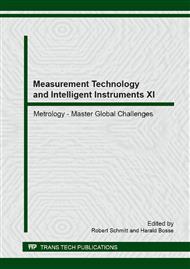[1]
David Handford, Alex Rogers, Kevin Cross, Agent-Based Traffic Operator Training Environments for Evacuation Scenarios, Web Intelligence and Intelligent Agent Technology, IEEE/WIC/ACM International Conference on, pp.438-441, August (2011).
DOI: 10.1109/wi-iat.2011.202
Google Scholar
[2]
Tomas Potuzak, Comparison of Road Traffic Network Division Based on Microscopic and Macroscopic Simulation, Computer Modeling and Simulation, International Conference on, pp.409-414, April (2011).
DOI: 10.1109/uksim.2011.84
Google Scholar
[3]
Toyotaro Suzumura, Hiroki Kanezashi, Highly Scalable X10-Based Agent Simulation Platform and Its Application to Large-Scale Traffic Simulation, 2012 IEEE/ACM 16th International Symposium on Distributed Simulation and Real Time Applications (DS-RT), pp.243-250, October (2012).
DOI: 10.1109/ds-rt.2012.44
Google Scholar
[4]
David Wilkie, Jason Sewall, Ming C. Lin, Transforming GIS Data into Functional Road Models for Large-Scale Traffic Simulation, IEEE Transactions on Visualization and Computer Graphics, pp.890-901, June (2012).
DOI: 10.1109/tvcg.2011.116
Google Scholar
[5]
Marianne Hatzopoulou, Jiang Y. Hao, Eric J. Miller (2011) Simulating the impacts of household travel on greenhouse gas emissions, urban air quality, and population exposure Transportation, p.38: 871–887, (2011).
DOI: 10.1007/s11116-011-9362-9
Google Scholar
[6]
Paruchuri, P., 2002. Multi agent simulation of unorganized traffic, AAMAS '02: Proceedings of the first international joint conference on Autonomous agents and multiagent systems, ACM Press, pp.176-183, (2002).
DOI: 10.1145/544741.544786
Google Scholar
[7]
Chang, G. and Junchaya, T., 1993. Simulating network traffic flows with a massively parallel computing architecture, WSC '93: Proceedings of the 25th conference on Winter simulation, ACM Press, pp.762-770, (1993).
DOI: 10.1145/256563.256840
Google Scholar
[8]
AL-Shihabi, T. and Mourant, R.R., 2001. A framework for modelling human-like driving behaviours for autonomous vehicles in driving simulators, AGENTS '01: Proceedings of the fifth international conference on Autonomous agents, ACM Press, pp.286-291, (2001).
DOI: 10.1145/375735.376310
Google Scholar
[9]
Lemessi, M., 2001. An SLX-based microsimulation model for a two-lane road section, WSC '01: Proceedings of the 33rd conference on Winter simulation, IEEE Computer Society pp.1064-1071, (2001).
DOI: 10.1109/wsc.2001.977415
Google Scholar
[10]
Gao, W., M. Balmer and E.J. Miller (2010) Comparisons between MATSim and EMME/2 on the Greater Toronto and Hamilton Area Network Transportation Research Record, Journal of the Transportation Research Board, No. 2197, p.118–128, (2010).
DOI: 10.3141/2197-14
Google Scholar
[11]
Müller, K. and K.W. Axhausen, Population synthesis for microsimulation: State of the art, the 9th Annual Meeting of the Transportation Research Board, Washington, D.C., January (2011).
Google Scholar
[12]
Joubert, W.J., P.J. Fourie and K.W. Axhausen (2010) Large-Scale Agent-Based Combined Traffic Simulation of Private Cars and Commercial Vehicles Transportation Research Record, Vol. 2168, pp.24-32, (2010).
DOI: 10.3141/2168-04
Google Scholar
[13]
Horni, A., D. M. Scott, M. Balmer and K. W. Axhausen (2009) Location Choice Modeling for Shopping and Leisure Activities With MATSim: Combining Micro-simulation and Time Geography Transportation Research Record, Vol. 2135, pp.87-95, (2009).
DOI: 10.3141/2135-11
Google Scholar


